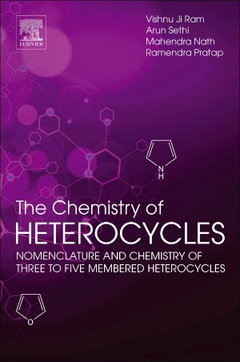Description
The Chemistry of Heterocycles
Nomenclature and Chemistry of Three to Five Membered Heterocycles
Authors: Ji Ram Vishnu, Sethi Arun, Nath Mahendra, Pratap Ramendra
Language: English
Subject for The Chemistry of Heterocycles:
193.44 €
In Print (Delivery period: 14 days).
Add to cart500 p. · 21.4x27.6 cm · Paperback
Description
/li>Contents
/li>Readership
/li>Biography
/li>Comment
/li>
Heterocycles are ubiquitously present in nature and occupy a unique place in organic chemistry as they are part of the DNA and haemoglobin that make life possible. The Chemistry of Heterocycles covers an introduction to the topic, followed by a chapter on the nomenclature of all classes of isolated, fused and polycyclic heterocycles. The third chapter delineates the highly strained three membered N,O and S containing aromatic and non-aromatic heterocycles with one and more than one similar and dissimilar heteroatom. The four-membered heterocycles are abundantly present in various natural and synthetic products of pharmacological importance. This chapter describes the natural abundance, synthesis, chemical reactivity, structural features and their medicinal importance. This class of compounds are present as sub-structures in penicillin and cytotoxic Taxol. Lastly, a chapter on the natural abundance, synthesis, chemical reactivity and pharmacological importance of 5-membered heterocycles with N,O,S heteroatom is covered. The chemistry of heterocycles with mixed heteroatom such as, N-S, N-O, N-S etc. is also described.
1. Introduction 2. Nomenclature of Heterocycles 3. Three Membered Heterocycles 4. Four Membered Heterocycles 5. Five Membered Heterocycles
Predominantly organic, heterocycle and medicinal chemists, at both academic and industrial levels. Particular interest for upper-level students and those teaching in these areas.
Prof Sethi has over 27 years of experience teaching graduate and post-graduate classes. He has written three popular text books on Practical chemistry as well as Basic Organic chemistry for graduate and postgraduate students. In addition, he has produced numerous research publications and review articles.
Prof Nath has over 10 years of teaching experience of graduate and postgraduate classes in the Department of Chemistry, Delhi University. He has been abroad as a postdoctoral fellow in Canada and USA for several years working on heterocyclic systems. At present, his research is also focused on the development of various heterocyclic systems including porphyrins and biomimetic metalloporphyrins. He has numerous publications and review articles.
Prof. Ramendra Pratap completed his master’s from the University of Gorakhpur in 2001 and then he moved to Central Drug Research Institute, Lucknow for doctoral research. He worked with Dr. Vishnu Ji Ram for four and a half years on ring transformation reactions of 2H-pyran-2-ones. He worked on nucleoside modification chemistry as a postdoctoral fellow at the City University of New York, USA, for two years. He received a renowned Humboldt fellowship and shifted to the University of Saarland, Germany. In Saarbrucken, he was involved in Mo-catalyzed reactions. In September 2010, He joined th
- Gives in-depth, clear information about various systems of nomenclature along with widely acceptable IUPAC system for naming various classes of heterocycles
- Provides complete information about natural occurrences, synthesis, chemical reactivity, pharmacological importance of heterocycles and their application in material science
- Highly relevant for graduate students and researchers, providing updated information about various isolated and fused N,O and,S containing heterocycles




